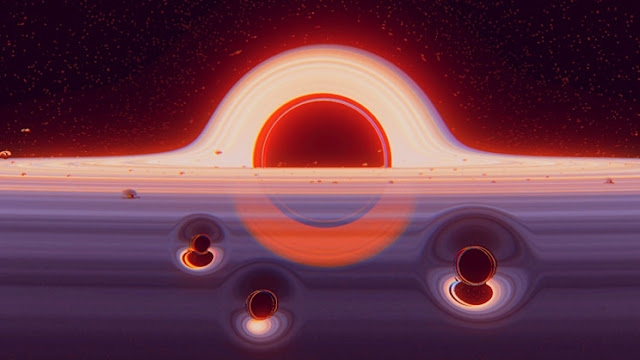Sometimes, there's no escape.
Scientists have discovered a supermassive black
hole that has trapped three other black holes in the monstrous disk swirling
around it, where time and space begin to twist and bend.
But with three black holes in such relative
proximity, the local environment of space-time has become a place where chaos
reigns — where gravitational waves smash into one another, stretching and
crushing the fabric of the universe itself, according to a recent study published
in the journal Nature.
Needless to say, nothing living would survive
long in there.
A supermassive black hole is bending the merging of smaller black holes
The new research explored a bizarre gravitational wave event witnessed in May 2019 that continues to baffle scientists. Gravitational waves are the ripple-like waves that propagate through spacetime when the fabric of physical reality is altered by extremely cataclysmic events, like black hole mergers. But the event in this study left one mid-sized black hole behind — and scientists can neither clearly see it nor explain it. Most mysterious is its circular path was oddly disrupted when the two black holes approached one another.
"The gravitational wave event GW190521 is the most surprising discovery to date," said Imre Bartos, co-author of the study and a physicist at the University of Florida, in a statement.
When the baffling signal first showed up in the
data, the scientists thought it might be a black hole merger in a region of
space where black holes were abundant. Star-sized black holes come into being
when a large star dies. Each is is roughly one-dozen times the mass of our Sun.
But supermassive black holes lurk in the center of entire galaxies (including
ours), and are comprised of enough matter to outweigh their stellar-sized
counterparts millions of times over.
That's a giant, heavy, reality-bending monster.
Never go near it.
A supermassive black hole lurking near a cataclysmic merger
And while the May 2019 merger probably resulted
in an intermediate-size black hole, roughly 100 to 1,000 times the mass of the
Sun, something was lurking nearby that made it difficult to comprehend
precisely how it came into being.
Astronomers hypothesized that one of the black
holes involved in the observed collision had been in one before — in essence,
saying that this wasn't its first rodeo.
If this were the case, the newly formed black
hole would be 142 times the mass of our Sun. But for two collisions to happen
in a row, the scientists examining GW190521 suggested that the observed event
happened in the proximity of an active galactic nucleus, containing an
especially dynamic supermassive black hole. This is a region of space
where black holes might be very abundant, where older stars with
enough mass to go critical and form into their own singularities are a common
occurrence.
But the more recent study looked into a new
possibility: The two black holes weren't swirling around each other's gravity
upon colliding. Instead, their orbits were elliptical, resembling colossal
ovals, rather than circles. This is something no one had seen before, since it
was thought that little could interfere with the immense gravity of two black
holes nearing impact.
Supermassive black holes disrupt the mergers of smaller ones
Physicists decided to model black hole collisions — and as soon as they
posited another, supermassive black hole in the vicinity, everything changed.
When you insert a supermassive black hole into this system, it creates a
massive disk of matter spinning around it, like a solar system only way, way
bigger.
And instead of planets, the active nucleus of a
galaxy (supermassive black hole) is surrounded by smaller, stellar-size black
holes that are scattered throughout the disk, like a handful of dark marbles
thrown into a funnel. The recent research identified this model as a nearly
two-dimensional system, because of the tremendous force of local gravity.
This caused the probability of an eccentric (or
oval-like) merger between two smaller black holes to skyrocket, up to 100 times
more likely, said Johan Samsing, an astrophysicist of the Niels Bohr Institute
in Denmark.
Eccentric tendencies - Roughly half of the mergers in such a disk would be eccentric, not circular.
"In these environments, the typical velocity and density of black holes [are] so high that smaller black holes bounce around as in a giant game of billiards and wide circular binaries cannot exist," said Astrophysicist Bence Kocsis of the University of Oxford, U.K., in the statement.
Now that this new dynamic black hole hellscape
has been revealed, the next step lies in finding more black hole collisions in
these environments. And, of course, never going there.


